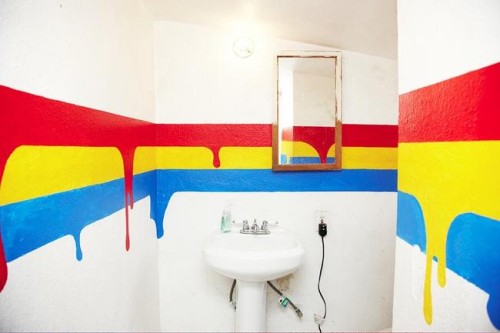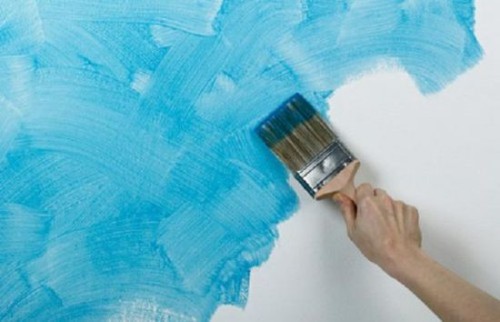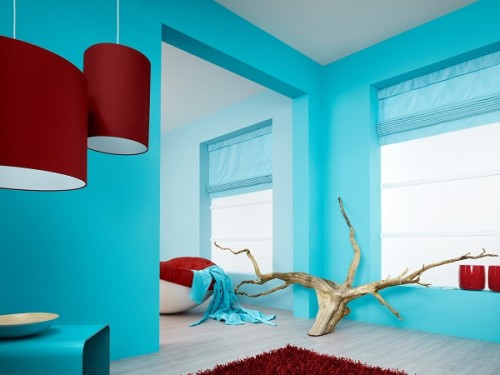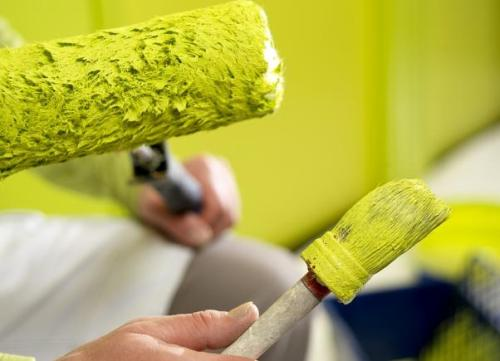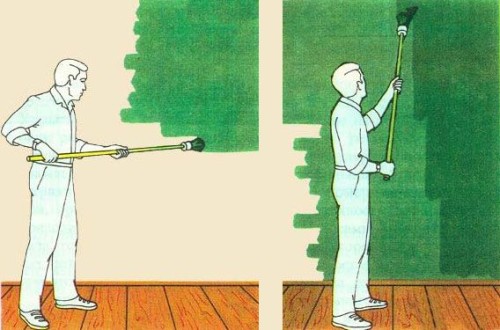
How to paint wall paint Walls
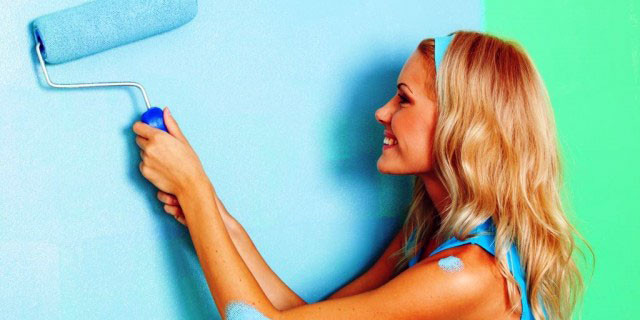
Painting of the walls is one of the most popular types of finishing not only the interior, but also external surfaces. Thanks to coloring technology, which is used in the preparation of paint to apply, it is possible to achieve interesting and non-standard tones that complement any design room design. Modern paints are distinguished by excellent resistance to abrasion and moisture effects, which makes it possible to significantly increase the interremmer period.
Content
With the replacement of an old colorful coating, almost everyone can cope with who at least once held a roller or brush in the hands. The walls of the apartment, painted paint, look quite attractive. How to paint the walls in your housing properly - hereinafter.
What paint is better to paint the walls
It depends on the right choice of paint - since it will look at the wall, before how long it will stay on the surface. Incorrectly chosen mixtures will be able to spoil the entire repair process at the constituent stage.
For painting walls indoors, the following types of paints are usually used:
- Oil mixtures (manufactured based on natural or synthetic oil).
- Enamel paints (the basis of them is varnishes).
- Adhesive mixtures (made on the basis of polymer adhesives).
- Water-level paints (such paints are made on the basis of water-soluble polymers).
Oil paints. This type of coverage was previously quite popular for the repair of premises, and now it is extremely rare. The popularity of this material was high mainly due to the lack of any alternative. The fact is that the oil paint has a number of serious disadvantages that limit its use in the repair work of the premises. It dries very long, while highlighting a specific smell that is harmful to health. Hyd, oil paint forms a thin film on the surface, which reduces the layer breathability. Because of this, paint, after a short period of time, begins to disperse and crack.
Currently, such paint is used for painting metal and wooden surfaces.
Marking of oil paints, according to the standard depends on their base:
- Ma-021 - made on the basis of natural oils.
- PF-024 - made on the basis of pentaphthalicic oil.
- GP-023 - made on the basis of glyphthali oil.
- Ma-025 - contains a combined olive.
Enamel. These paints are made on the basis of varnishes. Like oil paint, enamel is rarely used for painting walls.
Depending on how the foundation is used in the manufacture of enamels, distinguish: nitroemali, alkyd enamel polyurethane enamel, etc. A feature of such paints is that they dry pretty quickly. At the same time, the enamels allocate a very sharp smell, which does not allow working with them in closed rooms without the use of special means. This mixture is sold in the finished form in banks, which greatly simplifies work with it. When buying enamel, it is necessary to pay attention to its shelf life. Paints, which is stored for more than 1 year, loses its properties and its application may not give the expected result. In order to paint the wall of the enamel give the best result, the surface to which it is applied should have some roughness. This will give the ability to paint to have better adhesion, and, accordingly, a more even and strong layer.
Adhesive paints.. As already understandable from their name, the basis of such materials is glue. Such paint has very good performance characteristics, however, it is sold in the form of different components. To prepare paint, it is necessary time and experience that adds the problems to the one who makes the repair for the first time.
For the preparation of paint, you must have three tanks. In the first thoroughly mixed water and chalk in proportions 2/1. This solution must be broken within 2 hours. A dye is prepared in the second container. The powder is also mixed with water so that its consistency resembles the dough. The third container is prepared by the water-adhesive solution at the rate of 600 grams. Substances on 10 liters of water.
Then the dye and the water-chalk solution is mixed and its consistency is checked. To do this, the resulting mixture is lowered by a wooden stick polished to the smooth surface. The mixture should completely paint the surface without spaces. At the same time, it should not be too thick. If the mixture is very thick, water is added to it, otherwise - chalk.
After bringing the solution to the required density, it is painted with a small section of the wall in a negligence place. It is done in order to see the resulting paint color when it gets up. If it does not suit, it is adjusted by the addition of a kolator or chalk. The latter component is added a water-adhesive solution. At the same time, it is necessary to withstand the correct delicate of paint. With a large content of glue, after drying it can just crumble. In the back of the situation, after drying, the paint may noticeably change its shade. The thickness is checked by brush. From her, paint should be flipped with small jets. Only the cooked composition should immediately thicken, and then wrestling.
How to paint the walls of waterfront paint
These mixes are most popular among builders and designers for interior entrance. They are based on ordinary water in which special polymers are diluted.
Advantages of water-level paints:
- Fast drying. Painted surface with dry warm weather can dry out per day.
- No odors. Unlike enamels and oil paints, the water-emulsion has no smell, which is one of the key indicators for inside the premises. Due to its polymer structure, such paints do not cause allergic reactions.
- Excellent compatibility with color pigments. Thanks to this feature, you can create almost any shade of paint under the designer ideas.
- Due to the excellent moisture permeability, the walls, painted paint, "breathe", which practically makes it impossible to lag or cracking.
- The tool after working with water-level paint is easily cleaned with simple water.
The only condition for the use of this material is the temperature above + 5 ° C. Working with water-level paint at a temperature below can lead to its poor adhesion, which will necessitate the need to redo the work again.
When choosing water-level paint, you must pay attention to the conditions for its storage. The fact is that paint stored in low temperatures, in the event of its freezing, it flies and loses its properties. It is impossible to use it.
Preparation of walls to painting
Order of preparatory work:
- Preparation of walls to painting is mainly in the alignment of the surface. If the surface of the walls under the sticking of wallpaper can allow some flaws, then painting requires ideal. Align the walls, as a rule, with a plaster putty.
- After the installation of the installation work, all irregularities are aligned using a starting putty. It has a coarse-grained structure, therefore, it is capable of aligning even large deviations in the walls. Before applying putty, the surface is necessarily ground so that it is better to bed.
- The putty is prepared from a dry mixture and water with a mixer. It is necessary to ensure that it does not contain lumps. During the work, you need to check the flattering layer using the rule or level. With large surface drops, put splash several times, while in front of each stage the walls are ground.
- After the starting putty dry, proceed to applying the finish. It has a fine grain and makes the walls perfectly smooth and smooth. After applying and drying the material, the wall is grinning with a mesh grid and rejected again. If painting takes place in the furnished room, it must be released from furniture, technique and carpets. If removed everything does not work, the furniture can be put in the center of the room, so as not to put out in the paint.
How to paint the wall
Paint can be applied after the primer dry. To carry out such work, you will need:
- Small brush.
- Roller
- Malyary Scotch.
- Paint bath.
Order of work:
- First of all, it is necessary to open the can with paint and mix it thoroughly.
- After that, with the help of the brush, the material is neatly applied to hard-to-reach places. It can be internal or external angles of walls, an area near the plinth, batteries. Doing it carefully so as not to miss the islets.
- As soon as the painting of hard-to-reach places is finished, proceed to the main work. To do this, use a roller, with which the paint is "riveted" to obtain an even and homogeneous layer. Thanks to the use of roller, the process of painting is much facilitated and takes less time.
- It is quite convenient to work this tool. To do this, pour a little paint in the bath, lower the roller into it and swallow it from all the sides so that he evenly absorbed the paint. Then you need to roll it on the ribbed surface of the bath to remove the excess material.
- Paint is applied evenly into several layers and is well rolled. You need to apply paint first from top to bottom, then left to right, and again downward. After the first application, the paint is allowed to dry, then with good lighting check the quality of work and re-painting.




